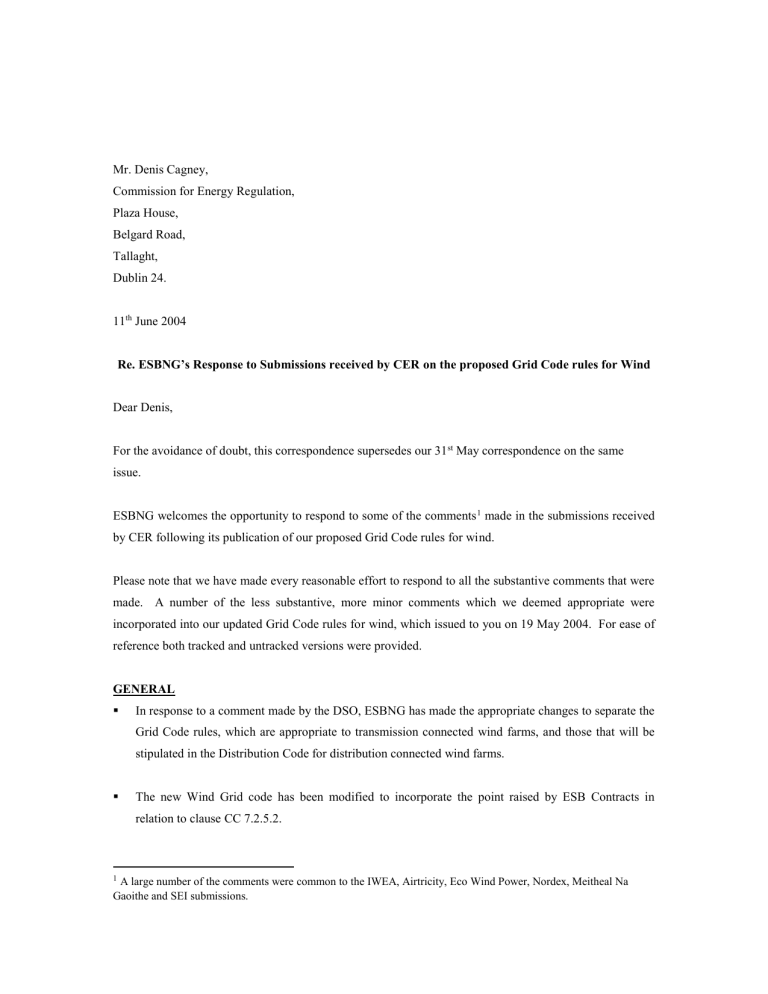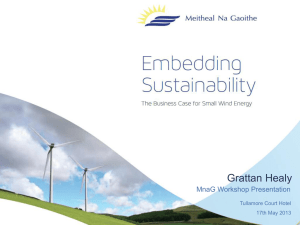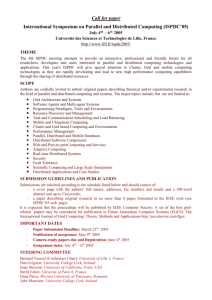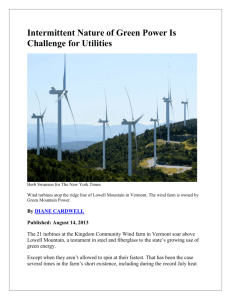Letter from ESBNG - Commission for Energy Regulation

Mr. Denis Cagney,
Commission for Energy Regulation,
Plaza House,
Belgard Road,
Tallaght,
Dublin 24.
11 th June 2004
Re. ESBNG’s Response to Submissions received by CER on the proposed Grid Code rules for Wind
Dear Denis,
For the avoidance of doubt, this correspondence supersedes our 31 st May correspondence on the same issue.
ESBNG welcomes the opportunity to respond to some of the comments 1 made in the submissions received by CER following its publication of our proposed Grid Code rules for wind.
Please note that we have made every reasonable effort to respond to all the substantive comments that were made. A number of the less substantive, more minor comments which we deemed appropriate were incorporated into our updated Grid Code rules for wind, which issued to you on 19 May 2004. For ease of reference both tracked and untracked versions were provided.
GENERAL
In response to a comment made by the DSO, ESBNG has made the appropriate changes to separate the
Grid Code rules, which are appropriate to transmission connected wind farms, and those that will be stipulated in the Distribution Code for distribution connected wind farms.
The new Wind Grid code has been modified to incorporate the point raised by ESB Contracts in relation to clause CC 7.2.5.2.
1
A large number of the comments were common to the IWEA, Airtricity, Eco Wind Power, Nordex, Meitheal Na
Gaoithe and SEI submissions .
In relation to the IWEA submission the definitions for “Curtailed Active Power” and “Voltage
Regulation” have been reworded.
The scope has been modified to be applicable to the TSO and Grid Connected Wind Farm Power
Stations.
The above have all been incorporated into our updated Grid Code rules for wind, which issued to CER on 19 May 2004.
In relation to the comment raised by Ecopower Limited about the applicability of the new Wind Grid
Code for existing plant, ESBNG’s view is that the new Grid Code and Distribution Code rules for wind should apply to all wind farms, including those already connected or under construction. A party’s right to seek derogations shall continue as provided for in the General Conditions of the Grid Code.
Implementation of the Wind Grid Code
Unlike countries in mainland Europe, Ireland is not anchored to the vast European synchronous power system and with the current numbers of operational wind farm sites, committed wind farm contracts and pending wind farm applications (~2200MW in total), ESBNG cannot afford to wait for other
European TSOs to drive the technology required to ensure reliability and security of operation. With the level of interest in wind being experienced in Ireland today, ESBNG is now at the leading-edge in that regard.
Ancillary Services
ESBNG require these services to ensure system security and in relation to receiving remuneration for any ancillary services provided, this is predominantly a matter for the CER.
Targets
The new wind Grid code was developed without explicitly considering the amount of wind that can or cannot be connected to the electricity system.
Members of the Wind Consultation Group
All the main Wind Turbine Generator (WTG) manufacturers were provided with the opportunity to become members of ESBNG’s Wind Grid Code consultation group. Only two confirmed their desire to do so prior to the first meeting of the group. To ensure that the group functioned effectively it was essential that the numbers from each representative group were limited. However, prior to each meeting all the WTG manufacturers were circulated with ESBNG’s proposal for the topic under consideration for the next meeting and given ample opportunity to submit any comments. Parties were
also provided with the opportunity to submit their comments through the IWEA or SEI representatives.
Subsequent drafts and final versions were also circulated. ESBNG also sat in on similar consultation group meetings held by SONI (System Operator Northern Ireland) and because SONI’s group had different manufacturer representation, ESBNG was also exposed to their views and concerns.
FAULT RIDE THROUGH 1
With respect to WPS1.4.2 b), some recent modelling studies show that adopting a requirement that following a low-voltage incident, a wind farm power station should provide 90% of its maximum available active power within 4 seconds, for example, could reduce the acceptable level of wind generation by 30% or more compared with the level that would be acceptable if a recovery to 90% within 1 second were adopted. Accordingly, ESBNG proposes that the original proposal requiring recovery to 90% within 1 second should remain.
The following sentences have been removed from WFPS1.4, ” The TSO reserves the right to require a more enhanced Fault Ride-Through capability, or refuse connection to the Network, for system security reasons. If applicable, this shall be notified by the TSO or DSO during the Connection Offer process
.”
ESBNG is not in favour of incorporating the provision of “micro-disconnection” into the Grid Code at this point. Micro-disconnection is proposed as a means of avoiding breach of the Grid Code requirements under certain circumstances. Thus, a turbine that requires micro-disconnection does not meet the grid code and would require a derogation. If it can be shown that micro-disconnection provides superior system security, that the circumstances in which this would be required are a tiny subset of normal operation, it will be considered by ESBNG. In addition, the effects on the system of the disconnection and reconnection must be identified. We do not believe that is prudent to incorporate micro-disconnection until we, and the relevant manufacturer(s), have had time to examine it fully. In view of the current timeframe for the Wind Grid Code, we are not favour of its inclusion.
FREQUENCY
For the avoidance of doubt in relation to table WFPS1.1, ESBNG shall advise each wind farm of a
“MW Curtailment Set-point” (if applicable). However, to ensure that the correct level of curtailment for each site is captured, the wind farm operator shall convert this “MW curtailment Set-point” to a “% of Available Active Power” value. If the windfarm operator has an alternative way of achieving the same end result this can also be explored.
Ecofys. raised the issue about undesirable inverse effects being introduced by basing frequency response on % of Available Active Power Output. The frequency response behaviour being sought
from wind generation was developed by taking into account the varying nature of wind generation output. In general, ESBNG operates the system to ensure that the system frequency is inside the normal operating range for most of the time. Where deviations of system frequency occur outside the normal operating range, it is generally the case that these frequency excursions are of very short duration. During this time, it is likely that the available output from all wind farms on the system will only have changed by a small amount. So, it will not make much difference if the frequency response system is based on % of Available Active Power Output. A frequency response system based on % of available active power will have a lower impact on the output from wind generation whilst still providing both high and low frequency response when required.
In response to the conflict highlighted by Meitheal Na Gaoithe in relation to WFPS1.5.2.2.9 and maximum ramp rate conditions where the wind farm is above 100MW, under normal operating conditions all wind farms must comply with the two maximum ramp rate limits (1 minute setting and
10 minute setting). However, under certain conditions where frequency has gone outside the normal operating range (or some other specified range), the response rate can exceed the two maximum ramp rate limits.
IWEA raised the question about whether ramp rates should only be limited during start-up or whether the lowest level of ramp rate limit should be set to 10% per minute with a minimum of 10 MW / minute over one minute and 5 MW / minute over ten minutes. From a system perspective, it is not just at times of start-up that ESBNG would be concerned about high ramp rates. ESBNG must operate a secure, safe and reliable system at all times. ESBNG have proposed ramp rates during the consultation process which should apply following approval of the Wind Grid Code. These values were based on a reasonable estimate on what would be required to allow conventional generation to respond to rapid changes in wind generation output over the next few years. No reasonable argument has been given as to why these settings proposed by ESBNG should not apply. It is likely that these ramp rate limit settings will be reviewed regularly as more wind generation connects to the system and more data becomes available to ESBNG. Based on these reviews, it may be possible to relax these limits in the future. Or, it may actually be necessary to make these limits more onerous.
VOLTAGE
In response to the IWEA comment referring to the inclusion of WFPS1.6.3.1, this was discussed at some length by the Wind Grid Code Consultation Group. The conclusion was that wording such as
WFPS1.6.3.1 should be included. This was confirmed in our subsequent discussions with the
Commission’s representative.
We have added a definition of “slope” to the glossary.
With regard to the specification of reactive power range at output levels below 10%, we believe that our proposal not to specify reactive power requirements at low output but to consider the circumstances of each wind farm power station as part of the evaluation of its connection application is more appropriate.
WFPS1.6.4.2 has been reworded as requested by Meitheal Na Gaoithe. The actual requirement will be specified in each wind farm’s connection agreement.
WFPS1.6.3.3 has been reworded as suggested by IWEA.
SIGNALS, COMMUNICATIONS AND CONTROL
WFPS1.7.1.3.2 & WFPS1.7.2.5 have been modified as suggested by the IWEA.
MW Forecasts
MW forecasting is required to predict the amount of wind generation on the system so that the TSO can plan the amount of convention generation and reserve required. This data is required a day ahead to allow time to develop the generation and supply strategy.
Curtailment
A curtailment policy is currently being developed by the CER in consultation with ESBNG. It is
ESBNG’s understanding that this proposal will at some stage in the future issue for public consultation. Therefore, it would be premature to comment on how curtailment will be implemented or to quantify the level of curtailment envisaged at this point. Hence, the new Wind Grid Code cannot be modified at this point to include possible limits of constraints. However, the Grid Code is a live document and may require a change depending on the outcome of the Curtailment Policy.
Responsible Operator
The requirement to have a Responsible Operator on site within 1 hour is necessary due to the fact that as more wind farms connect to the system more reliance is placed on them from a system security and reliability perspective. The option of not including this is as a requirement will lead to less efficient operation of the system and the introduction of unnecessary risks.
Yours sincerely,
Simon Grimes
Manager Codes & Agreements






